|
LOD 1 screenshots
|
|
| Elbarto84 | Date: Saturday, 31.03.2012, 04:23 | Message # 1 |
|
Space Tourist
Group: Users
 Brazil
Brazil
Messages: 37
Status: Offline
| I've managed to let Space Engine use my normal RAM as well as VRAM. (thanks to this thread http://en.spaceengine.org/forum/11-515-1 )
With this i am able to put it as far as LOD 1 and it will take just 20 seconds to load! LOD 2 i tried but i got impatient after a minute hehe
The cool part about it is that i can switch between LOD -2 to LOD 1 instantly without loading after the initial loading of a body has finished. Everything is stored in RAM. I cruise around with LOD 0 and if i see something interesting i switch to LOD 1.
I am beyond happy as i can now finally have an amazing Space Engine experience (Thanks Space Engineer!) 
All images below are unedited and came straight from the screenshot folder =)





Full album here -> http://imgur.com/a/pIh8e
Edited by Elbarto84 - Saturday, 31.03.2012, 04:24 |
| |
| |
| Destructor1701 | Date: Saturday, 31.03.2012, 14:45 | Message # 2 |
|
Pioneer
Group: Users
 Ireland
Ireland
Messages: 533
Status: Offline
|  I MUST see this planet for myself... location? I MUST see this planet for myself... location?

|
| |
| |
| Elbarto84 | Date: Saturday, 31.03.2012, 15:16 | Message # 3 |
|
Space Tourist
Group: Users
 Brazil
Brazil
Messages: 37
Status: Offline
| Here you go! I bumped it up to LOD 2 (works very fast at some distance) I've hidden the stars and galaxies for a clearer picture.
Direct link to full size image

Edited by Elbarto84 - Saturday, 31.03.2012, 15:17 |
| |
| |
| mustafa2812 | Date: Saturday, 31.03.2012, 16:13 | Message # 4 |
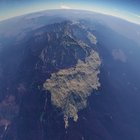 Space Pilot
Group: Users
 United States
United States
Messages: 121
Status: Offline
| How did you do this!!!??? I must know??!!!
EDIT: Never mind I see the thread
PC specs: Windows 7 64 bit. Intel Core i5-2400 quad-core (3.1GHz, 6MB Cache). 6GB DDR3-1333MGz SDRAM[2 DIMMs]. 1 TB 7200 rpm SATA 3Gb/s hard drive. 3GB DDR3 NVIDIA GeForce GT 545.
Edited by mustafa2812 - Saturday, 31.03.2012, 16:15 |
| |
| |
| Elbarto84 | Date: Saturday, 31.03.2012, 16:24 | Message # 5 |
|
Space Tourist
Group: Users
 Brazil
Brazil
Messages: 37
Status: Offline
| The odd thing is that i have an ATI card, not an nVidia as stated in that thread =) And I have only 512mb of VRAM.
Edited by Elbarto84 - Saturday, 31.03.2012, 16:26 |
| |
| |
| Androll | Date: Sunday, 01.04.2012, 06:26 | Message # 6 |
|
Observer
Group: Users
 Poland
Poland
Messages: 12
Status: Offline
| Did you use some additional tweaks? (shaders, config files, etc.) I can't achieve this quality no matter what.  Look below. Look below.
Using SE v 0.951 without any mods.
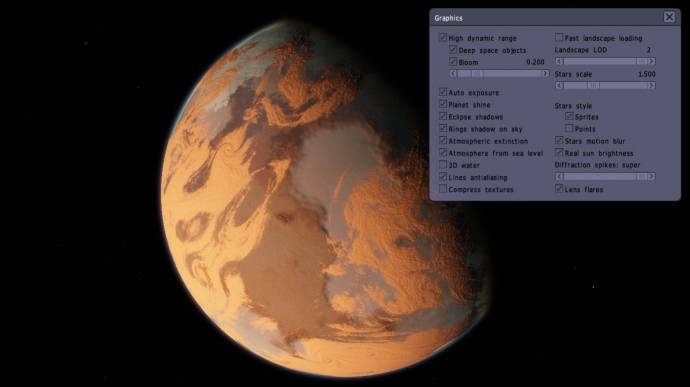
Intel Core2Duo E7200 3,3 GHZ, ATI Radeon HD 4870 X2, 2 GB DDR-2 800MHz, HDD 500Gb :P
|
| |
| |
| Hardts | Date: Sunday, 01.04.2012, 11:46 | Message # 7 |
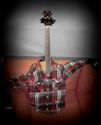 Space Pilot
Group: Users
 Denmark
Denmark
Messages: 112
Status: Offline
| Quote (Androll) Did you use some additional tweaks? (shaders, config files, etc.) I can't achieve this quality no matter what. Look below.
i5 2500k 3,3 GHz @3,6GHz
8 GB 1600 MHz DDR3
3HDD (1TB+500GB+320GB)
Gainward Gtx 460 1GB
2 monitors: Samsung 27" P2770, 22" Samsung BW226
+A sh*tload of palmtree's around my computer :)
|
| |
| |
| SimonDoo | Date: Sunday, 01.04.2012, 12:20 | Message # 8 |
 Observer
Group: Newbies
 France
France
Messages: 9
Status: Offline
| Hello,
I was also very impressed by this screenshot, and I've never got this kind of surface texture and details at LOD 2 (please see the image in attachment below, same date and position as in your #3 message). I also thought that you modified something in the shaders or config files... 
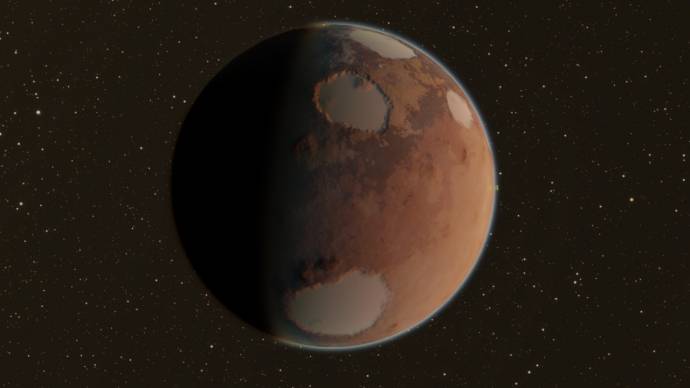
Asus G74SX - Core i7 - 2670QM, 2.2Ghz - 8GB Ram
Nvidia GeForce GTX 560M - 3GB - v285.74
Win 7 Home Premium 64-bit - DirectX11
Edited by SimonDoo - Sunday, 01.04.2012, 12:21 |
| |
| |
| Androll | Date: Sunday, 01.04.2012, 12:32 | Message # 9 |
|
Observer
Group: Users
 Poland
Poland
Messages: 12
Status: Offline
| Quote (Hardts) Specs (your computer)?
ATI Radeon HD 4870 X2, 2GB ram, C2D E7200 3,3GHZ, Windows 7 x86, and fresh copy of SE downloaded from depositfiles. No mods.
Intel Core2Duo E7200 3,3 GHZ, ATI Radeon HD 4870 X2, 2 GB DDR-2 800MHz, HDD 500Gb :P
|
| |
| |
| RAF_Blackace | Date: Sunday, 01.04.2012, 12:35 | Message # 10 |
|
Astronaut
Group: Users
 United Kingdom
United Kingdom
Messages: 55
Status: Offline
| I agree, I think you have modified the shaders to get much larger details than the default shaders produce. This is also at LOD2 and the same object, no such detail exists using the default shaders. It would be helpful if you could tell us exactly what you modified, it may be useful to others.
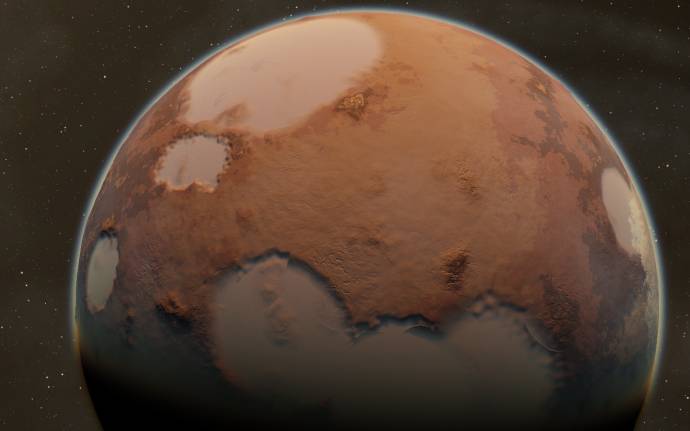
|
| |
| |
| Siciliec | Date: Sunday, 01.04.2012, 13:36 | Message # 11 |
|
Observer
Group: Newbies
 Ukraine
Ukraine
Messages: 1
Status: Offline
| In tg_terra_height.glsl uncomment(delete //) these lines:
Code //noiseOctaves = 10.0;
//distort = 0.2 * fBmVec3(p * 15.2);
//vec2 cell = Cell3Noise2(25.51 * (p + distort));
//hills = smoothstep(0.0, 1.0, abs(cell.y - cell.x));
//massif = saturate((global - seaLevel - 0.05) / 0.07) * 2.0 - 1.0;
//massif = 1.0 - montes*montes;
Or download glsl file and rename to tg_terra_height.glsl
Edited by Siciliec - Sunday, 01.04.2012, 13:39 |
| |
| |
| RAF_Blackace | Date: Sunday, 01.04.2012, 15:02 | Message # 12 |
|
Astronaut
Group: Users
 United Kingdom
United Kingdom
Messages: 55
Status: Offline
| Hmmm. Well, there are two reasons to not modify Shaders.
1. You have a unique universe no one else can replicate (unless they do the same).
2. Changing shaders generally causes tears and distortion in normal maps. I have tried some of Rodrigos Shader changes only to find they create tears and distortion on some planets.
However, for screenshots they can be useful. Providing the poster makes it clear that they are not using default shaders.
|
| |
| |
| Elbarto84 | Date: Sunday, 01.04.2012, 17:14 | Message # 13 |
|
Space Tourist
Group: Users
 Brazil
Brazil
Messages: 37
Status: Offline
| I have indeed modified a number of things, sorry that i didn't clarify that since the beginning. However i didn't expect the difference to be so huge from everyone else. I had not visited this Moon before messing with the settings so i had no idea it normally looked like the screenshots above.
First of all i edited the Main.cfg a little bit to get greater detail. The lines in red i changed.
Main.cfg
//////////////////////////////////////////////////
// SpaceEngine main configuration file //
//////////////////////////////////////////////////
// universe configuration file
UniverseConfig "config/universe.cfg"
// display settings
ClientSizeX 1280 // window client area width
ClientSizeY 720 // window client area height
FullScreen false // use fullscreen mode
AspectRatio 1.0 // aspect ratio for displays with non-square pixels
UseDesktopSetting false // use desktop settings for fullscreen mode (fullscreen window style)
ScreenSizeX 1280 // screen x resolution (when UseDesktopSettings false)
ScreenSizeY 720 // screen y resolution (when UseDesktopSettings false)
DisplayRefresh 60 // refresh frequency (when UseDesktopSettings false)
// OpenGL settings
VSync true // use vertical syncronization
AnisotropyLevel 16 // anisotropy filtering level (0 - disable anisotropy)
LineWidth 2.0 // lines width
LineSmooth true // lines antialiasing
// memory settings
VideoMemorySize 2048 // video card onboard memory (VRAM) in megabytes. note: i have only 512mb
VideoMemoryMaxPercent 80 // max VRAM consumption (percents)
VideoMemoryStartupDetect false // use auto detection of VRAM size on startup, otherwise use VideoMemorySize value
VideoMemoryDynamicDetect false // use auto detection of available amount of VRAM in runtime
GalaxySysModelCacheSize 5 // do not change this!
ClusterStarModelCacheSize 200 // do not change this!
// interface settings
//GUILanguage "rus" // localization
GUIMode 2 // text info mode
GUIMessageTime 2000 // splash message duration (milliseconds)
GUICursor "q3cursor.*" // cursor texture
GUIGraphCursor false // use textured cursor instead of system cursor
GUICursorSize 16 // textures cursor size
GUIJournalSize 100 // maximum size of autopilot journal
// texture rendering settings
TRMaxImpostors 16 // max number of impostors
TRMaxSkyBoxes 1 // max number of skyboxes
TRFloat false // use floating-point impostors (for HDR)
TRImpResolution 0.333 // impostor resolution (fraction of ClientSizeX)
TRSkyResolution 0.333 // skybox resolution (fraction of ClientSizeX)
TRImpUpdateThreshold 0.005 // impostor update threshold
TRSkyUpdateThreshold 0.0006 // skybox update threshold
TRSkyMinFOV 60.0 // skybox min FOV
TRSkyMaxStep 0.00005 // skybox max velocity (normalized on object's radius)
TRBlackHoleResolution 1024 // resolution of black hole billboard
TRLensFlareConvRadius 3 // lens flare convolution radius
// planets settings
PlanetMipMapping true // use mipmapping for landscape textures
PlanetSphereMeshLOD 5 // spherical meshes detail
PlanetCubeMeshLOD 5 // landscape meshes detail
PlanetRingsSubdiv 16 // planetary rings datail
PlanetDetailCraters 0.0001 // approx. min radius of craters on terrestrial planets (kilometers)
PlanetDetailTerra 0.00001 // approx. per vertex detail on terrestrial planets (kilometers)
PlanetDetailClouds 0.0001 // approx. per vertex detail on coluds (kilometers)
PlanetDetailGasGiant 0.1 // approx. per vertex detail on gas giant planets (kilometers)
PlanetDetailSun 1.0 // approx. per vertex detail on stars surface (kilometers)
PlanetDetailTexScale 32768 // scale of detail textures
// stars settings
StarColorShift 0.0 // color shift ("+" red, "-" blue)
StarColorSaturation 1.0 // color saturation
StarScale 1.5 // scale of stars, distant planets and galaxies, etc. particles
StarFrustumClipFOV 30.0 // max frustum clipping FOV
StarSolTexBright 2.1 // surface texture brightness (temperature) multiplier
// magnitude limit settings
PlanetMagnLimit 7.0 // planets limiting magnitude
StarMagnLimit 7.0 // stars limiting magnitude
GalaxyMagnLimit 7.0 // galaxies, nebulae and clusters limiting magnitude
GlowMagnLimit 4.0 // galaxies and nebulae sprites limiting magnitude
PlanetBrightMin 0.03 // planets cutoff pixel brightness
StarBrightMin 0.03 // stars cutoff pixel brightness
GalaxyBrightMin 0.03 // galaxies, nebulae and clusters cutoff pixel brightness
GlowBrightMin 0.006 // galaxies and nebulae sprites cutoff pixel brightness
// screenshots and other settings
ScreenshotFormat "jpg" // screenshot format (jpg, png, dds, tga)
VideoFrameFormat "jpg" // video frames format (jpg, png, dds, tga)
JpegQuality 99 // jpeg compression quality
RealTime true // use RealTime mode (velocity not depend on FPS)
RealTimeFPS 24.0 // RealTime mode velocity calibration (FPS for video capture)
ConvertRGBAtoPNG false // if true, any loaded RGBA or Grayscale images are saved in PNG format in the same directory
NSplashImages 14 // number of splash window textures (data\textures\common\splash*.*)
// debug settings
UseGalaxiesOctree true // use catalog galaxies octree
UseCatStarsOctree true // use catalog stars octree
ShowGalaxiesOctree false // show catalog galaxies octree
ShowCatStarsOctree false // show catalog stars octree
ShowGalSysOctree false // show galaxy subsystems octree
ShowPlanetsQuadtree false // show planets bounding boxes
ShowGalaxiesBBoxes false // show galaxy model bounding boxes
ShowNebulaeBBoxes false // show nebula model bounding boxes
// disable OpenGL extensions for old hardware
IgnoreFBO false // disable framebuffer objects
IgnoreHalfFloat false // disable half floats
IgnoreFloatTextures false // disable float textures
Ignore3DTextures false // disable 3D textures
IgnoreCriticalCheck false // ignore checking of OpenGL version and critical extensions supporting
// turn off problem functionality
BugClipping false // distant galaxies clipping
BugCraters false // procedural craters bug on ATI (suspending or crash)
BugMipmaps false // mipmap generation bug on ATI (crash)
BugCracks false // bug with cracks in landscape on NVidia
// loading settings
PreloadShaders true // preload some shaders on startup
LoaderBenchmark false // log loading/creating times
LoaderMode 1 // loader mode: 0 = immediatly, 1 = interleaved, 2 = asynchronous
LoaderTiming 10.0 // max loading/creating time per frame in Interleaved mode (milliseconds)
tg_terra_height.glsl
(because i liked the Canyons 2.0 from another thread i decided to mess around some more in this file)
#ifdef _VERTEX_
void main()
{
gl_Position = ftransform();
gl_TexCoord[0] = gl_MultiTexCoord0;
}
#else
float HeightMapTerra(vec3 point)
{
noiseH = 1.0;
noiseLacunarity = 2.218281828459;
noiseOffset = 0.8;
float massif, global;
vec3 distort;
vec3 p = point * mainFreq + Randomize;
// Global landscape
noiseOctaves = 15;
distort = 0.35 * fBmVec3(p * 2.37);
noiseOctaves = 4;
distort += 0.005 * (1.0 - abs(fBmVec3(p * 132.3)));
global = 1.0 - Cell3Noise(p + distort);
// Venus-like structure
float venus = 0.0;
if (venusMagn > 0.05)
{
noiseOctaves = 4;
distort = fBmVec3(point * 0.3) * 1.5;
noiseOctaves = 6;
venus = fBm((point + distort) * venusFreq) * venusMagn;
}
global += venus;
global = (global - seaLevel) * 0.5 + seaLevel;
// Dunes
float dunes = 0.0;
if (dunesSqrtDensity > 0.005)
{
noiseOctaves = 3;
massif = Cell2Noise(point * 3.5 + 0.2 * fBmVec3(point*5.12));
massif = 1.0 - smoothstep(0.0, 1.0, massif / dunesSqrtDensity);
if (massif > 0.0)
{
noiseOctaves = 5.0;
dunes = dunesFreq + fBm(p * 3.21);
dunes = max(fBm(p * dunes) + 0.7, 0.0);
dunes = dunesMagn * massif * dunes;
}
}
// "Eroded" hills
float hills = 0.0;
if (hillsSqrtDensity > 0.05)
{
noiseOctaves = 3;
massif = Cell2Noise(point * 4.0 + 0.2 * fBmVec3(point*5.12));
massif = 1.0 - smoothstep(0.0, 1.0, massif / hillsSqrtDensity);
if (massif > 0.0)
{
noiseOctaves = 10.0;
noiseH = 1.0;
noiseOffset = 1.0;
hills = hillsMagn * massif * (1.5 - RidgedMultifractal(point * hillsFreq + Randomize, 2.0));
//noiseOctaves = 10.0;
//distort = 0.2 * fBmVec3(p * 15.2);
//vec2 cell = Cell3Noise2(25.51 * (p + distort));
//hills = smoothstep(0.0, 1.0, abs(cell.y - cell.x));
}
}
// Canyons
float canyon = 0.0;
if (canyonSqrtDensity > 0.05)
{
noiseOctaves = 2;
massif = Cell2Noise(point * 3.8 + 0.2 * fBmVec3(point*5.12));
massif = 1.0 - smoothstep(0.0, 1.0, massif / canyonSqrtDensity);
if (massif > 0.0)
{
noiseOctaves = 8;
canyon = 2.5 * dunesFreq + fBm(p * 3.21);
noiseH = 1.0;
noiseOffset = 1.0;
//canyonFreq + 30.0 * fBm(p * 1.321);
float canyonWidth = 0.65 * clamp(1.0 - 1.5 * massif, 0.3, 2.0);
canyon = pow(abs(fBm(p * canyon)), canyonWidth);
canyon = smoothstep(0.0, 1.0, (canyon - 0.5) * 6) - 1.0;
canyon = canyon * massif * canyonMagn;
}
}
global += canyon + (dunes + hills) * clamp(70 * (global - seaLevel), 0.0, 1.0);
// Mare
float mare = global;
if (mareSqrtDensity > 0.05)
{
craterDistortion = 1.0;
noiseOctaves = 6; // Mare roundness distortion
mare = MareNoise(point, global, 0.0);
}
// Craters
float crater = 0.0;
if (craterSqrtDensity > 0.005)
{
noiseOctaves = 1; // Craters roundness distortion
craterDistortion = 01.0;
craterRoundDist = 0.5;
heightFloor = -0.1;
heightPeak = 0.9;
heightRim = 5.0;
crater = CraterNoise(point, 0.5 * craterMagn, craterFreq, craterSqrtDensity, craterOctaves);
noiseOctaves = 10.0;
noiseH = 1.0;
noiseOffset = 6.0;
crater = RidgedMultifractalDetail(point * 0.3 * montesFreq + Randomize, 2.0, 0.25 * crater);
}
// Mountains
float montes = 0.0;
if (montesSqrtDensity > 0.05)
{
noiseOctaves = 5;
massif = Cell2Noise(point * 8.5 + 0.2 * fBmVec3(point*5.12));
massif = 2.0 - smoothstep(0.0, 2.0, massif / montesSqrtDensity);
//massif = saturate((global - seaLevel - 0.05) / 0.07) * 2.0 - 1.0;
//massif = 1.0 - montes*montes;
if (massif > 0.0)
{
noiseOctaves = 20.0;
noiseH = 1.0;
noiseOffset = 1.0;
montes = montesMagn * massif * RidgedMultifractal(point * montesFreq + Randomize, 2.0);
}
}
//float height = mare + crater + montes;
float height = mare + crater + montes * clamp(5 * (global - seaLevel), 0.0, 1.0);
// Assign a climate type
noiseOctaves = (cloudsStyle == 1.0) ? 5.0 : 12.0;
noiseH = 1.5;
noiseLacunarity = 2.218281828459;
noiseOffset = 0.8;
float climate, latitude;
if (tidalLock == 0.0)
{
latitude = abs(point.y);
latitude += 0.15 * (fBm(point * 0.7 + Randomize) - 1.0);
latitude = saturate(latitude);
}
else
{
latitude = 1.0 - point.x;
latitude += 0.15 * (fBm(point * 0.7 + Randomize) - 1.0);
}
// Ice caps
float edge;
if (cloudsStyle == 1.0)
{
edge = saturate(15.0 * (latitude - latIceCaps));
height = height * 0.1 + icecapHeight * edge;
}
else
{
edge = saturate(3.0 * (latitude - latIceCaps));
height += icecapHeight * sqrt(edge);
}
return height;
}
void main()
{
vec3 point = GetSurfacePoint();
//float height = max((HeightMapTerra(point) - seaLevel) / (1.0 + montesMagn), 0.0);
float height = HeightMapTerra(point);
gl_FragColor = vec4(height);
}
#endif
I'm interested to see some screenshots of the results if anyone will change the files =) Make a backup first of course.
Edited by Elbarto84 - Monday, 02.04.2012, 17:31 |
| |
| |
| Androll | Date: Sunday, 01.04.2012, 19:27 | Message # 14 |
|
Observer
Group: Users
 Poland
Poland
Messages: 12
Status: Offline
| Thanks for sharing!  Result: Result:
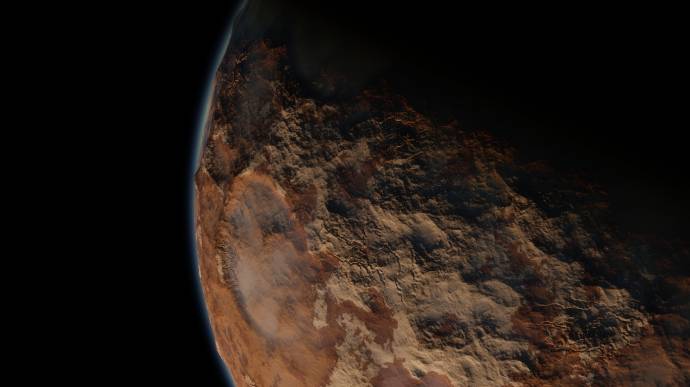
Intel Core2Duo E7200 3,3 GHZ, ATI Radeon HD 4870 X2, 2 GB DDR-2 800MHz, HDD 500Gb :P
|
| |
| |
| RAF_Blackace | Date: Sunday, 01.04.2012, 20:53 | Message # 15 |
|
Astronaut
Group: Users
 United Kingdom
United Kingdom
Messages: 55
Status: Offline
| Actually you dont need to do most of that, all you need to do is remove the forward slashes dissabling the following two lines of code in tg_terra_height.glsl file.
//massif = saturate((global - seaLevel - 0.05) / 0.07) * 2.0 - 1.0;
//massif = 1.0 - montes*montes;
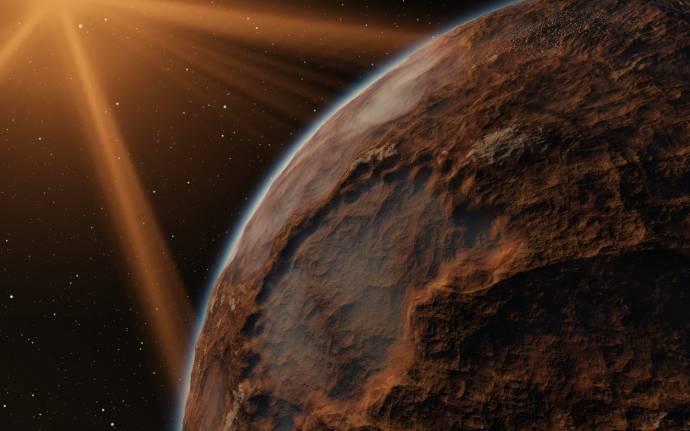
|
| |
| |